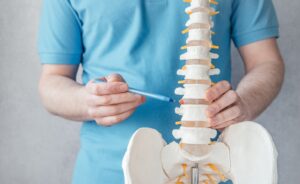HERNIATED DISCS
What’s a Herniated Disc?
 A herniated disc is a specific injury involving one of the rubbery cushions that sit between the individual bones (vertebrae) that make up your spine.
A herniated disc is a specific injury involving one of the rubbery cushions that sit between the individual bones (vertebrae) that make up your spine.
Spinal discs have a soft, spongy center called a nucleus, encased inside a tough, rubbery exterior called an annulus. Also known as a slipped disc or a ruptured disc, a herniated disc occurs when a piece of the nucleus squeezes out through a tear in the annulus.
A herniated disc, which can occur in any spine level, can then put pressure on a nearby nerve. Depending on the location of the herniated disc, it can cause pain, numbness or weakness in an arm or leg.
Symptoms of a Herniated Disc
Most often, spinal discs tend to herniate in the lower back (Lumbar Spine), although they may also occur in the neck (Cervical Spine). Signs and symptoms depend on the location of the affected disc and the impinged nerve.
- Arm or leg pain. If a disc herniates in the lower back, patients will typically feel pain in the buttocks, thigh and calf, and possibly the foot as well. If a disc herniates in the neck, patients typically feel the most pain in the shoulder and arm. This pain may shoot down your arm or leg when you cough, sneeze, or move into certain positions.
- Numbness or tingling. People with a herniated disc often experience radiating numbness or tingling in the body part served by the affected nerves.
- Weakness. Muscles served by the affected nerves tend to weaken. This can cause patients to stumble, or affect their ability to lift and hold items.
What Causes a Herniated Disc?
Disc herniation most often occurs due to gradual, age-related wear and tear known as disc degeneration. As you age, the discs lose their flexibility, making them prone to tearing or rupturing with even a minor strain or twist.
Sometimes, using your back muscles instead of your leg and thigh muscles to lift heavy objects can lead to a herniated disc, as can twisting and turning while lifting. Traumatic injury may cause herniated discs, but far less often than other causes.
Treatment:
Treatment options for a herniated disc depend on the severity of symptoms and the individual’s condition. Common approaches include:
- Conservative Treatment: Rest, physical therapy, pain management, and anti-inflammatory medications may help manage symptoms and promote healing.
- Epidural Steroid Injections: These injections can deliver anti-inflammatory medications directly to the affected area to reduce pain and inflammation.
- Surgery: Surgical intervention might be considered if conservative treatments are not effective or if there is significant nerve compression. Procedures such as discectomy (removal of the herniated portion of the disc) might be performed.
Recovery:
Many people with herniated discs experience improvement in symptoms with conservative treatment. It’s important to follow the guidance of a healthcare provider and avoid activities that worsen symptoms. Physical therapy and exercises that strengthen the muscles supporting the spine can also aid in recovery.
If you suspect you have a herniated disc or are experiencing symptoms such as severe back pain, radiating pain, numbness, or weakness, consult a healthcare provider for proper evaluation and guidance tailored to your condition.
IF YOU NEED TO SEE A SPECIALIST, CONTACT US TO SCHEDULE YOUR APPOINTMENT TODAY!
Contact Us
Ask a question or book an appointment below.
